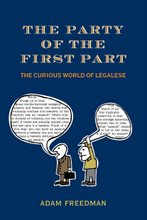
From the Indo-Asian News Service: Indian Law Secretary T.K. Vishvanathan has made a plea for clearer legislative drafting.
In particular, Mr. Vishvanathan took aim at long-winded sentences. "Long sentences intimidate the readers, while also making the law lose its spirit," he said, adding that "present legal draftsmen too like their co-professional forefathers love to test the agility of their readers by making them leap wide gaps between the subject and the verb, and the verb and the object in the sentences written by them."
He offered an interesting theory that the tradition of lengthy sentences in statutes comes from the fact that the early parliamentary draftsmen in England had been conveyancers (and conveyancers, evidently, used particularly long sentences). Can anyone comment on this theory?


3 comments:
I've not heard the conveyancer theory. Another theory is that a legal concept and all its qualifiers must be in the same sentence:
"For many drafters, the unit of truth is the sentence. . . . On this line of reasoning, each sentence must be true taken by itself--that is, its truth or falsity cannot be allowed to depend on some other sentence or sentences. (Perhaps this view stems from fear that any single sentence might be torn from its context by a plaintiff's lawyer.)"
—Howard Darmstadter, Hereof, Thereof, and Everywhereof: A Contrarian Guide to Legal Drafting 41 (ABA 2002).
"Often, overlong sentences are the result of the drafter attempting to address, in one fell swoop, all facets of a given provision by stringing together clauses that could constitute sentences in their own right and piling on exceptions, qualifications, and conditions. Breaking such sentences down into their constituent components often makes them easier to read and does not affect meaning."
--Kenneth A. Adams, Legal Usage in Drafting Corporate Agreements 123-124 (Quorum Books 2001).
Is it possible that conveyancers developed this theory--that a concept and all its qualifiers must be in the same sentence?
Good question. I've seen the single-sentence theory before, and that certainly afflicts statutory drafting. I'm not sure... I've also read that legal scriveners used to be page by the page and therefore developed the tradition of verbal padding out of greed. Could be that that's what the conveyancers were up to, but I'm really not sure. Anyone else out there?
is one of the labels that never become outdated. Designing by ed hardy sale one of the best tattoo artists that ever lived, these clothes will clearly deposit the suffering of time- trend sensible. cheap ed hardy Being able to buy clothes that are considered to be forever in tailor is indeed challenging. ed hardy online shop The key to this feat is actually unadorned. ed hardy swimwear You must forever reminisce that in shape, ed hardy hats it is very important that the designs are well-thought of, ed hardy sunglasses and reflects all types of personalities. ed hardy belts If a consumer relates to the mode, then you can be assured that the individual will always feel at diminish with what he is tiresome. ed hardy mens This is the debate why you should actually christian audigier think about what clothes fit your own form before selling them.
Post a Comment